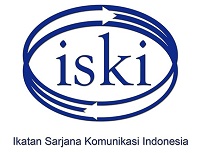State News Agency Frames on Terrorist Attack : Study in TVNZ New Zealand and news.lk Sri Lanka
Abstract
Many of the global mass media tend to deliver a particular news frame in a terrorism case, especially linkage terrorism with certain religions, races, at so on. The global mass media is influenced by Western media. The news frame will be different from the news agency level. This article aims to discuss news frame by the national news agencies in New Zealand (TVNZ) and Sri Lanka (news. lk) in a terrorism case, using the Robert N. Entman frame model. The result shows TVNZ defines the problem as an unprecedented action and creates a dark history in the country, the cause of the problem is terrorists from outside New Zealand, moral judgments in the form of evidence that New Zealand society remains united, the victims are also part of the New Zealand family regardless of their background, so the recommended resolution of the problem is that the government guarantees the safety of Muslim communities. Differently, news.lk defines the problem as the motive of the attack as revenge with religious sentiment. Meanwhile, the security forces are not aware of the threat, that define the cause of the problem as the perpetrator is an organized group and an indication of religious sentiment. This media makes moral judgments by revealing the fact that Muslims not guilty, the government facilitates representatives of the religious community in Sri Lanka to express their opinions to find solutions for reconciliation and maintaining peace. The recommended resolution is that the government is ready to fight terrorism without foreign intervention, improve the performance of the security forces, and reveal the active role of the different Sri Lankan people's ethnicity and religion.
Keywords
Full Text:
PDFReferences
Aliff, S. M. (2015). Post-War Conflict in Sri Lanka: Violence against Sri Lankan Muslims and Buddhist Hegemony. International Letters of Social and Humanistic Sciences, 109–125. https://doi.org/10.18052/www.scipress.com/ilshs.59.109
Devotta, N. (2018). Religious intolerance in post-civil war Sri Lanka. Asian Affairs, 49(2), 278–300. https://doi.org/10.1080/03068374.2018.1467660
Du, Y. R., & Li, L. (2017). When press freedom meets national interest: How terrorist attacks are framed in the news in China and the US. Global Media and China, 2(3), 284–302. https://doi.org/10.1177/2059436418755761
Eriyanto. (2002). Analisis Framing: Konstruksi, Ideologi, dan Politik Media. PT LKIS.
Fikri, M, A. (2016). War as entertainment: cermatan terhadap pemberitaan isu teror dalam new media. Jurnal Komunikasi Universitas Tarumanegara, 6(3), 74–84. https://doi.org/http://dx.doi.org/10.24912/jk.v6i3.41
Junaedi, F. (2017). Relasi Terorisme dan Media. Jurnal ASPIKOM, 1(1), 15–25. https://doi.org/10.24329/aspikom.v1i1.5
Kriyantono, R. (2014). Teori Public Relations Perspektif Barat dan Lokal (The Theory of Public Relations in Western and Local Perspectives). Jakarta: Kencana.
Ozdeser, H., Cavusoglu, B., & James, O. T. (2019). Terrorism Will Not Survive in the Realm of New Zealand. Journal of City and Development, 1(1), 23–27. https://doi.org/10.12691/JCD-1-1-4
Powell, K. A. (2018). Framing islam/creating fear: An analysis of U.S. media coverage of terrorism from 2011–2016. Religions, 9(9). https://doi.org/10.3390/rel9090257
Primayanti. (2015). Kajian Manajemen Produksi Pemberitaan Pso Bidang Pers Oleh Lkbn Antara. Jurnal Visi Komunikasi, 14(01), 75–89.
Quraishy, B. (2005). Islamic Images and Terminology. MediaTor, 6(1), 67–74. https://doi.org/https://doi.org/10.29313/mediator.v6i1.1177
Rantanen, T., Jääskeläinen, A., Bhat, R., & Al., E. (2019). The future of national news agencies in Europe: executive summary. The London School of Economics and Political Science.
Satriani, A. (2018). Framing Analysis of News Article about Clashes between Police and Terrorist Prisoners in Indonesia Publishing by ABC.net.au and SBS.com. Mediator: Jurnal Komunikasi, 11(2), 248–255. https://doi.org/10.29313/mediator.v11i2.3947
Sukarno, A. W. (2011). Dilema Peliputan Terorisme dan Pergeseran Pola Framing Berita Terorisme di Media Massa. Jurnal Ilmu Sosial Dan Ilmu Politik, 14(3), 333–348. https://doi.org/10.22146/JSP.10932
Sultan, K. (2016). Linking Islam with Terrorism: A Review of the Media Framing since 9/11. Global Media Journal: Pakistan Edition, 9(2), 1–10.
von Sikorski, C., Schmuck, D., Matthes, J., & Binder, A. (2017). “Muslims are not Terrorists”: Islamic State Coverage, Journalistic Differentiation Between Terrorism and Islam, Fear Reactions, and Attitudes Toward Muslims. Mass Communication and Society, 20(6). https://doi.org/10.1080/15205436.2017.1342131
Walker, C., & Orttung, R. W. (2014). Breaking the news: The role of state-run media. Journal of Democracy, 25(1), 71–85. https://doi.org/10.1353/jod.2014.0015
Ward, C., Stuart, J., & Adam, Z. M. (2019). A critical narrative review of research about the experiences of being Muslim in New Zealand. New Zealand Journal of Psychology, 47(1), 37–48.
Watanabe, K. (2017). Measuring news bias: Russia’s official news agency ITAR-TASS’ coverage of the Ukraine crisis. European Journal of Communication, 32(3), 1–18. https://doi.org/10.1177/0267323117695735
Yusof, S. H., Hassan, F., Hassan, S., & Osman, M. N. (2013). The framing of international media on Islam and Terrorism. European Scientific Journal, 9(8), 104–121.
Zhang, X., & Boukes, M. (2019). How China’s flagship news program frames “the West”: Foreign news coverage of CCTV’s Xinwen Lianbo before and during Xi Jinping’s presidency. Chinese Journal of Communication, 0(0), 1–17. https://doi.org/10.1080/17544750.2018.1554593
DOI: https://doi.org/10.29313/mediator.v13i2.6385
Refbacks
- There are currently no refbacks.

This work is licensed under a Creative Commons Attribution 4.0 International License























